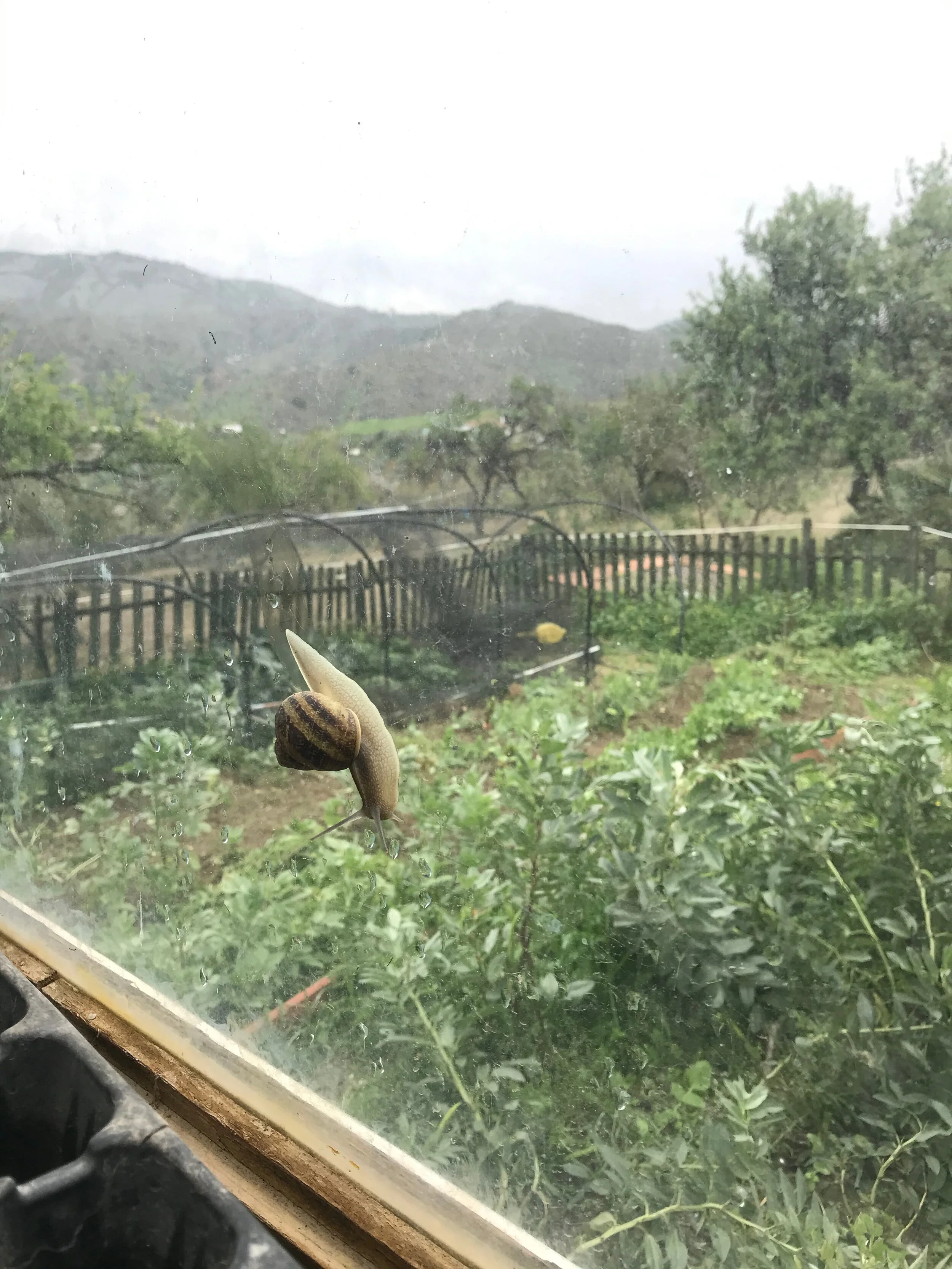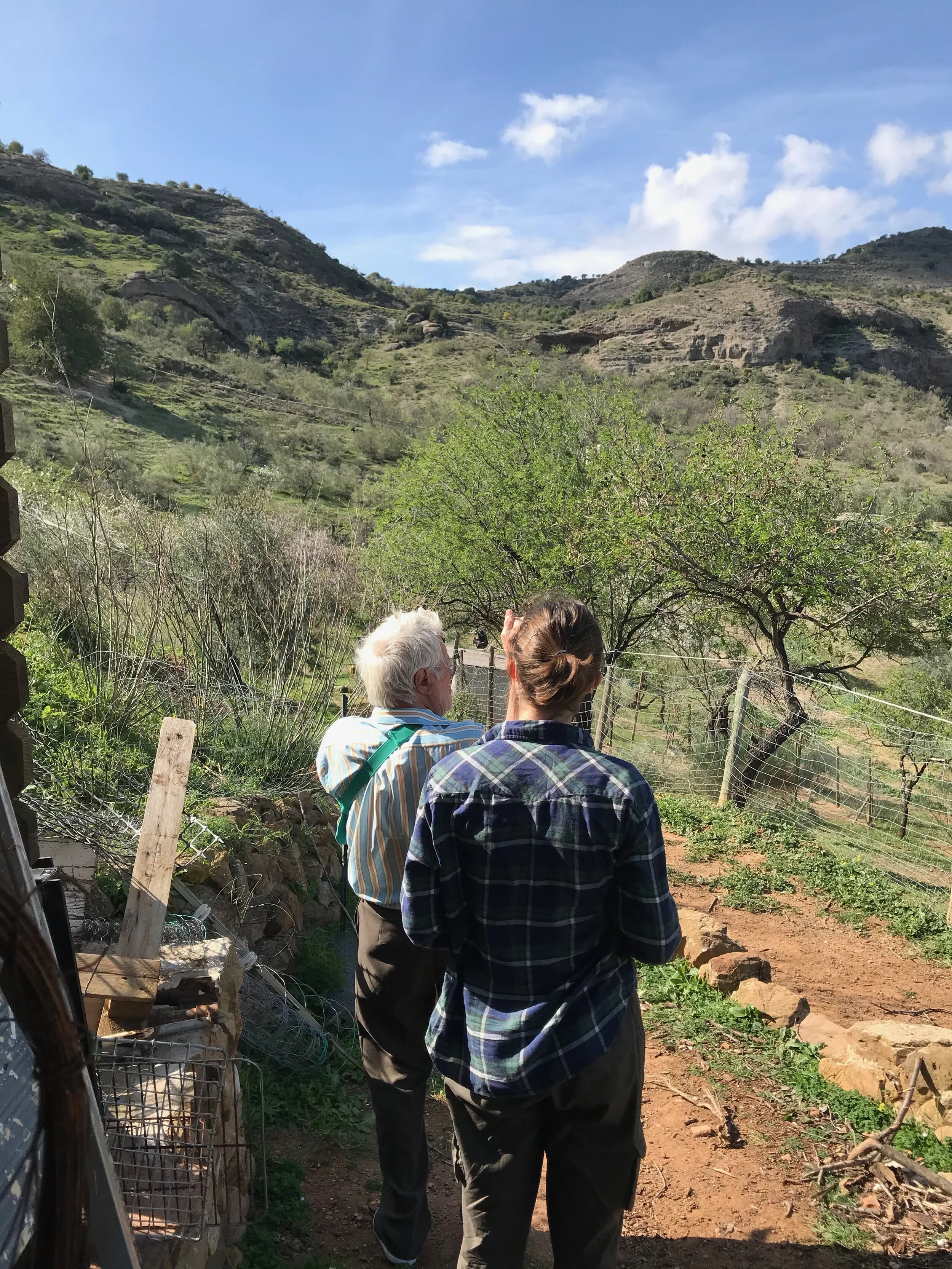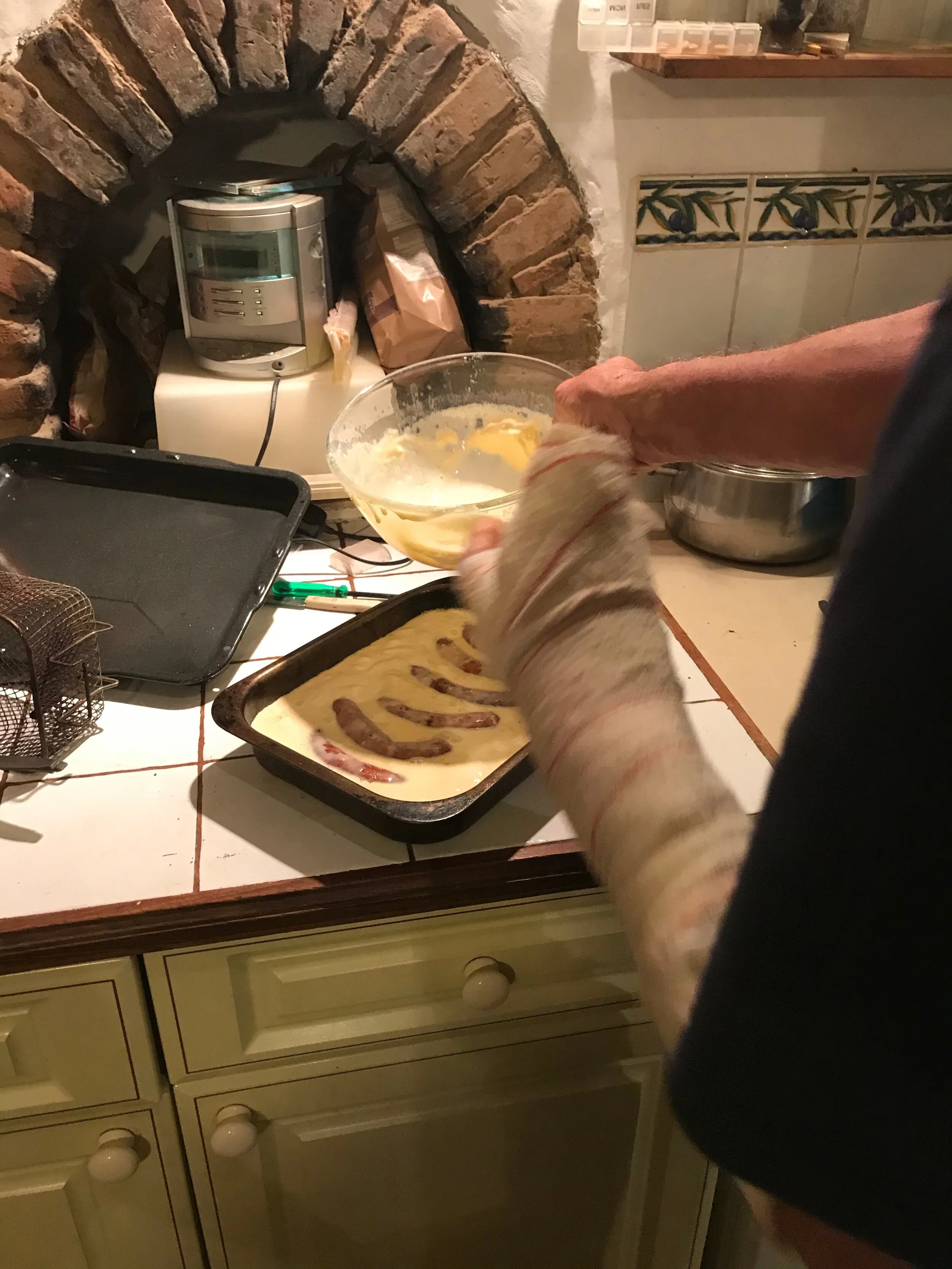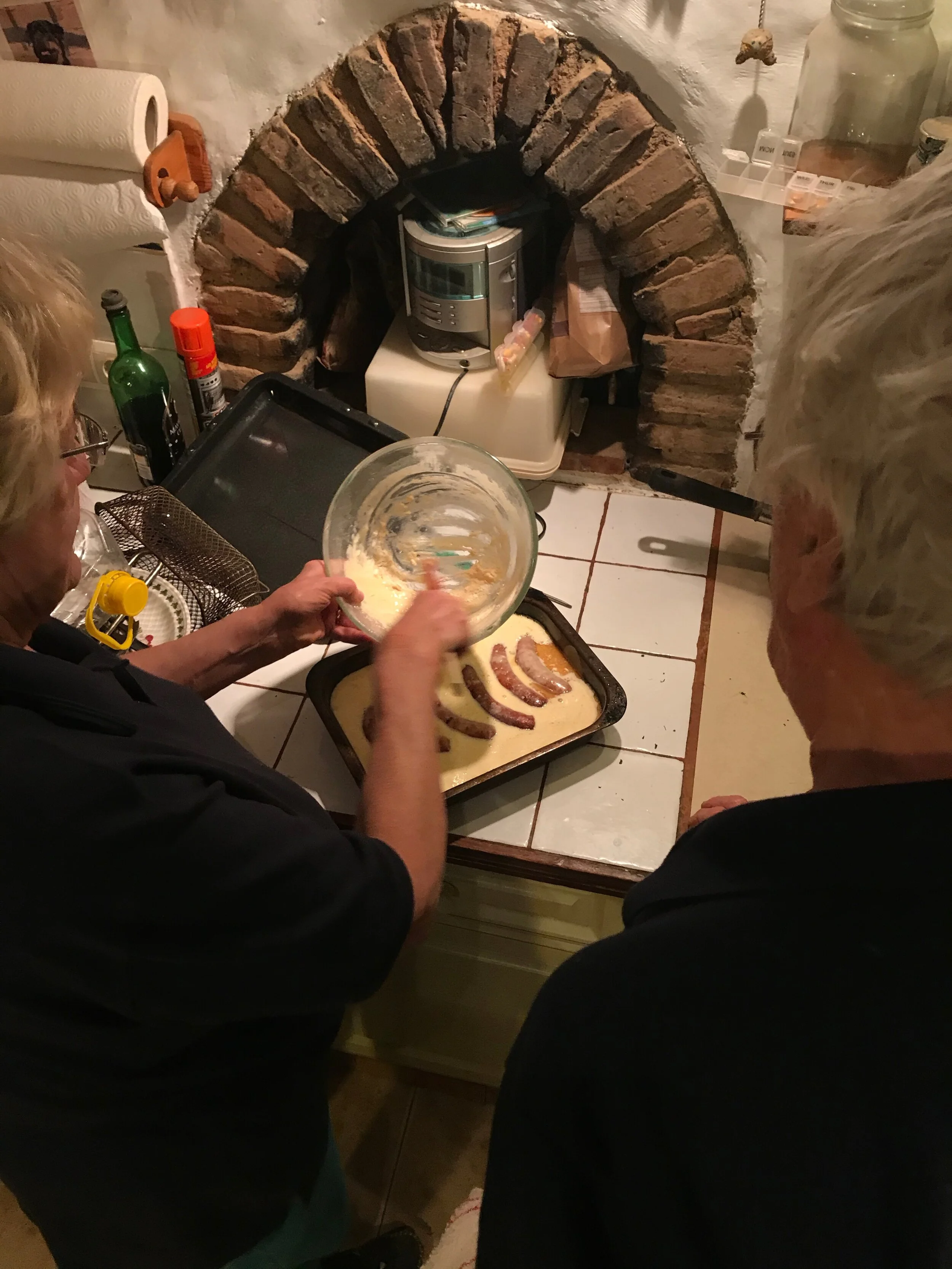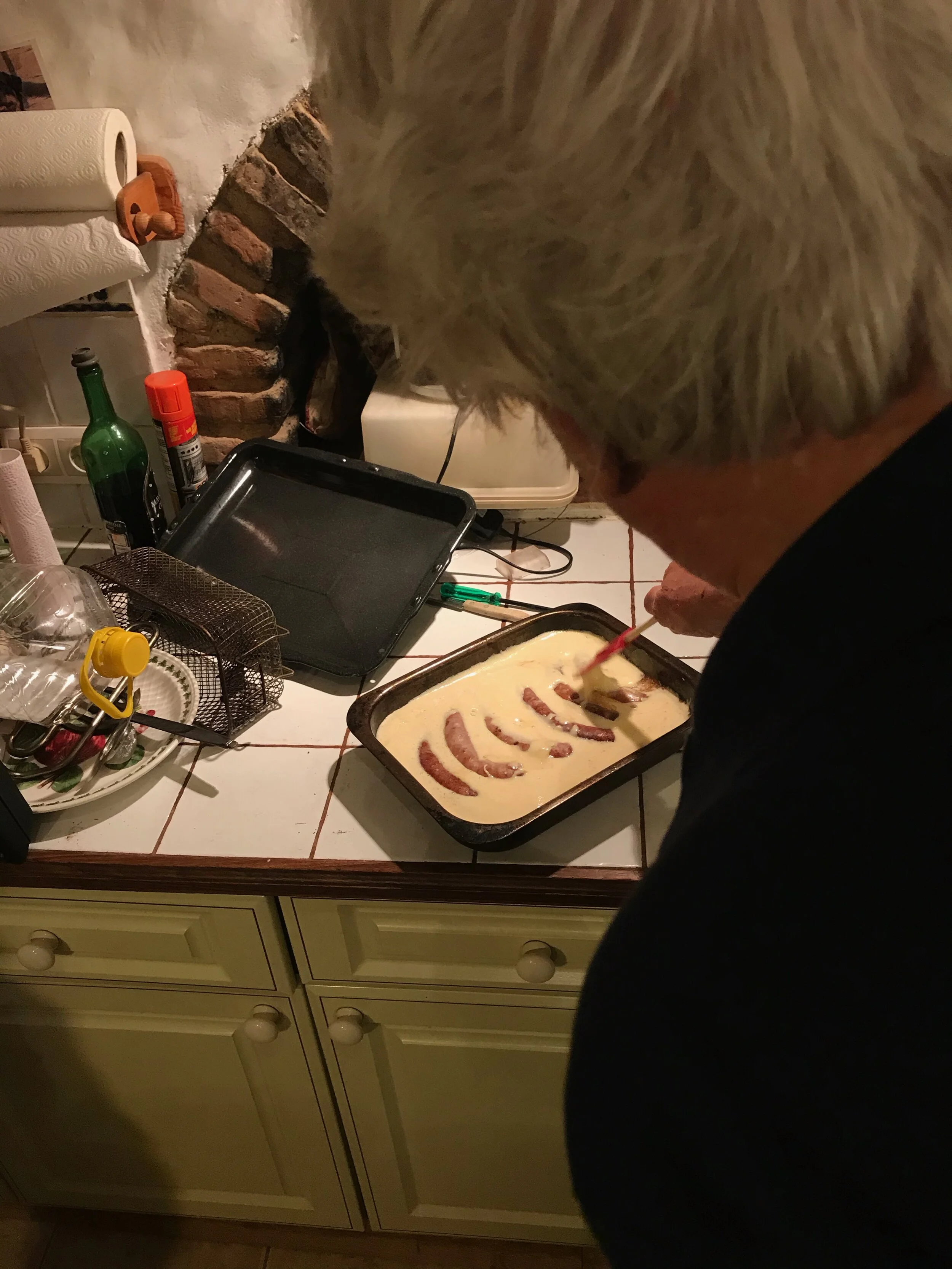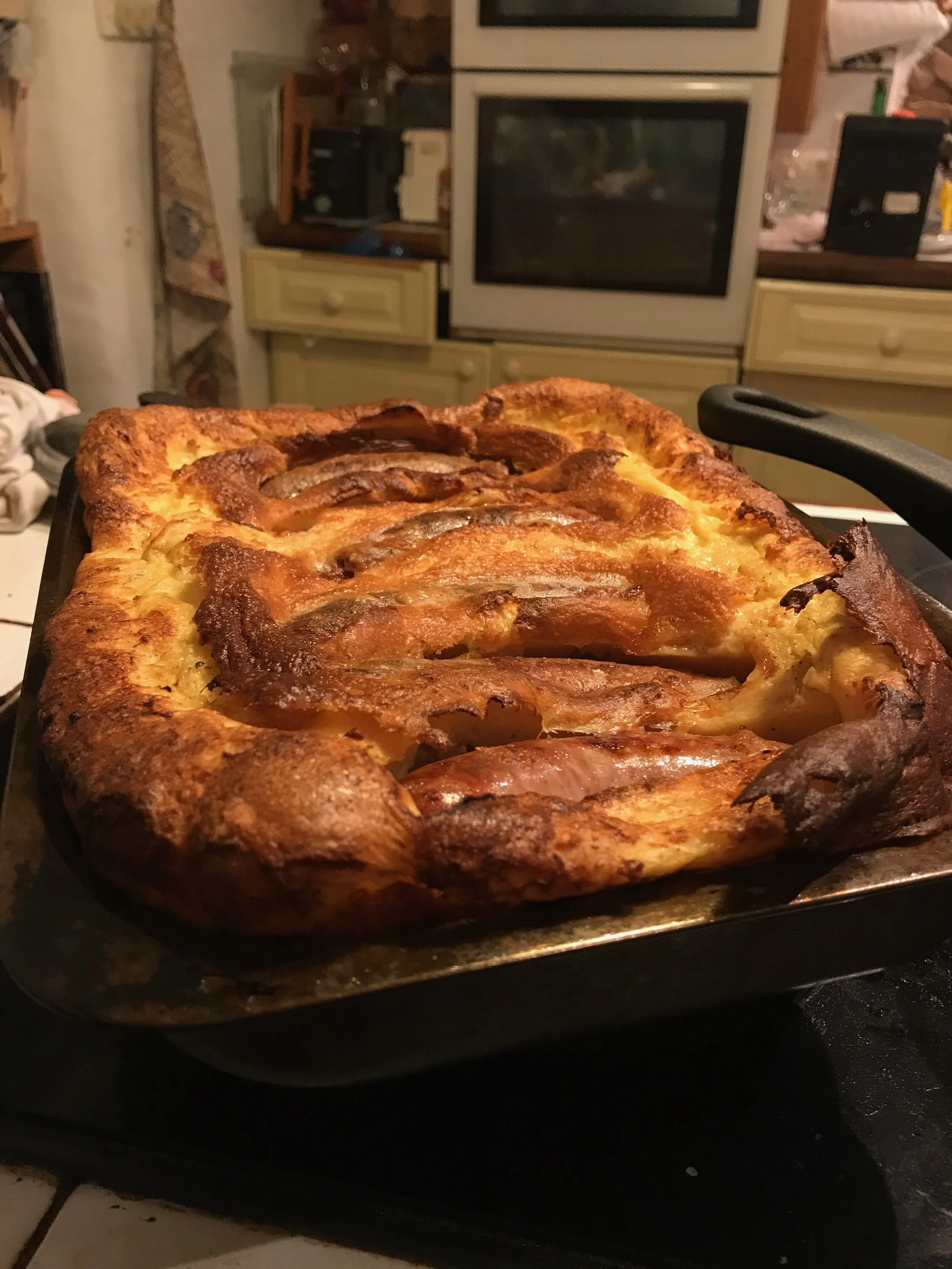George & Gloria Part II: A VERY ANDALUSIAN BAKEWELL TART
That the first new recipe I learned in Spain was a hyper-regional English tart may come as a surprise. That it also happens to be the most perfect encapsulation of the mountainous desert of Andalucía and our hosts there is just the powdered sugar on top.
Part II, For Part I
We woke early that first day, finally able to make out our new surroundings in the morning light. The finca was situated high on the western side of a desert vale, terraces of almond and fig - newly blossoming, their delicate pinks and whites adding some of the only color to the gray and rust landscape - falling over each other down towards a horse pen at the bottom of the property. (“The one horse is from really great stock, bought off a Spaniard for cheap. He collected horses like Americans collect cars, but had to sell when the recession finally hit Spain. Beautiful animal, but needs to be broken in, refuses to let anyone ride it. The other is an old mare, super sweet, and a great ride. But she refuses to go out without another horse. Which is all to say, we have two useless horses we can’t ride.”)
Finca Ria Grana
The view from our casita (small house) would have looked out onto the sunrise if not for the foothills directly across the way which delayed any direct light from reaching the finca until mid-morning. This fact, along with the design of the house - traditional Andalusian, with thick, plastered-over, stone walls and red-tile floor and roof - meant our quarters stayed preternaturally cool; a grateful relief come afternoon siesta when the sun was high and a chilling pain-in-the-ass most mornings. Smoke billowed from the black iron pipe of chimney on the main house, beckoning us to coffee and tea, to warmth.
We walked down the gravel drive towards breakfast, dodging the odd turd along the way, and passed above the small overgrown garden, winter weeds snaking their way through each of four terraced plots, choking out the broad beans and whatever little else had already been planted (this would be our primary work while staying with George and Gloria). Something about the space struck my as very British, perhaps that all the tools seemed impossibly old, seen only in the illustrations of Beatrix Potter paperbacks, or perhaps that everything seemed a perfectly organized chaos; a random place for everything, and everything (mostly) in its place.
Posts and pots of all sizes were precariously stacked on the uppermost level, near the compost and piles of ash and leaves. On the next plot down, a small greenhouse. In the shifting light of morning you could make out lazy sticky spirals in the glass, a sign of invisible hordes of snails, echoed (more menacingly) in the holey leaves of pea plants germinating inside. Outside the house, and spread throughout the garden’s two other levels, inseparable trios of trowel, hand-rake, and overturned bucket hid amongst the weeds, beckoning us to set and spend a few minutes - or hours, or days - making things right.
A yipping at the end of the drive drew us from daydreams of freshly raked soil and back to the nippy morning. A mangy and lovable terrier, Bodie, hopped on hind-legs in greeting, or warning - it was impossible to tell, and unthreatening either way.
Brian and Breezy
Saffi (Saffron) Eating on Roof
Approaching the house in the light now, it was obvious that it had been built piecemeal, rooms at a time, until something resembling livable space had sprung up in these unlivable surroundings. Like a refrigerator-box fort, new rooms and wings jutted out from the lean-to like original structure, which now functioned as the kitchen and dining room. This 500 square foot space, George told me, was the only building on the property when they first bought in 1999; a small shack, technically a stable, where the previous owner had lived along with his donkey. In fact, because the valley is zoned only for agriculture almost all of its human-dwellings are technically on the books as some of the most elaborate stables and goat pens you’ve ever seen, though most function only as weekend casitas: late on a summer Thursday, small lean-tos across the valley, masquerading as tool sheds at the edge of almond and olive groves, are flung open to reveal the makings of a weekend long fiesta: long tables and chairs, enough to seat 20, impossibly stuffed inside; string lights unraveled and wound through the trees; large butane burners, 20 quart pots, and a paella pan - seemingly as wide as the structure itself - liberated from their hooks in the ceiling, lit, and filled with rice, all manner of seafood, and pig; and of course, tucked in the last square foot of space, the radio, blasting the yips, claps, and aye-ayes of Andalusian revelry across the valley and to certain English neighbors’ chagrin.
Smelling coffee and toast, we ducked into the entryway, framed like the other original windows and doors with roughly hewn timber, knotty and worn with age. Like the surrounding countryside, the house sits at all odd and imperfect angles (“do watch your head”). Dogs of all sizes and types greeted us - or not, some lay listlessly, not even bothering to turn their heads, and one (the same from the night before) was on the roof awaiting breakfast. Gloria was busily filling bowls for the puppies (it turns out nine was only the count of permanent canine residents, there were currently ten others, from two litters, residing in the custom kennels out back). She was well-established in the kitchen, and from our vantage on the other side of the island, appeared to be all bosom, from countertop to shoulders. She had on a well-worn polo which, probably at one point marigold, had faded to the color of butter - good, grass-fed and pale yellow - over many years of washing. This mirrored her sandy blonde hair, a contrast to the dark eyebrows in between, raised always in stern judgement or mild amusement (you could never be certain which), above her glasses.
“So glad you made it,” she paused what she was doing, kissing first Breezy’s then my cheeks, “ahh, and you’re taller than I expected.” Before I could figure how to respond, she thrust two mugs of coffee into our hands and turned away to continue her chore, shouting over her shoulder and the din of dry kibble clanking into metal, “Did George tell you why we get so nervous over missing workers?” She was referring to our being two hours late the previous evening and we both awkwardly sipped at the too hot and too weak coffee. “A few years back we had a lad and his dog on their way from Granada to come work. They never turned up - no message, no call. And, shame, turns out he was murdered, poor thing.” We sat in shock, not at the story itself but at the brusqueness of its delivery. She stopped what she was doing, both hands resting on the rim of a bowl. “I just couldn’t believe it. And you know the worst part,” she pondered, less for us than herself: “The authorities never did find his dog.”
The intense awkwardness of the moment was lifted as George came into the kitchen followed by Fedor, who’d had to help him get dressed considering his slung arm. His shirt was tucked into the elastic waste of a pair of track pants (“Only seven Euro at the Chinese market! Probably made by slaves, but great for when you only have one arm!”) and the collar was popped for some reason, echoing the fly-about hair on his head and making him look like a vampire Phileas Fogg. He poured himself a tea (also too weak; for their first few years in Spain, the expats avoided the non-refrigerated boxed milk common here, and so developed the habit of brewing both coffee and tea gas-station-weak) and began to tuck into breakfast; which is to say, he fumbled around one-handed with his toast for so long that Gloria stomped across the room, spread butter followed by her homemade fig jam (he preferred jam and she Marmite) to the very edges of the bread, and rather violently cut it in half before sliding the toast in front of him. He began to eat and to discuss the days plans, gesticulating wildly and spilling crumbs as he did.
Born in Essex, and presumably buttering his own toast from a young age, George worked as an eco-engineer, designing smart-buildings for banks and local governments from Reykjavik to Hong Kong. This career trajectory markedly exceeded the expectations of his family, teachers, and most everyone else he knew: told in high school that he may not be capable of even custodial work, George eschewed college and took up a job at his father’s London butcher shop. There, bored one day of meat and blood, he took a particular interest in their refrigerator units which needed repair. George returned to school to study engineering and was drawn early to new and enigmatic technologies, which in the 60’s, meant that he became one of a handful of refrigerator-men proficient at computing. From then on, pulling himself up by the twin boot straps of ingenuity and good timing, he led a successful career at the head of his field. Though not so successful he could afford to retire to a French Chateau or a beach house on the Canaries. No, instead, after a career in refrigeration and eco-design, George now finds himself in a renovated donkey stable in the middle of the Spanish desert with no air conditioning and sporadic power (though he has recently installed four 8 foot solar panels).
Gloria still works as an eldercare nurse on occasion, flying home to England for sporadic jobs with regular clients (on the way back from which she smuggles all manner of her favorite English ingredients: Coleman’s mustard, specialty teas, her beloved Marmite). She met George in the 90’s: he was in his 50’s, divorced, and with grown kids, she in her 40’s, unmarried, and with a strong dislike of children. He’s addicted to TV, she detests it. For every whiskey soda he pours himself, she refills her champagne. And he won’t even touch Marmite.
It’s possible our wide-eyed and straightforward American-ness clouded our judgement, but through the constant chiding, and ribbing, and dense-as-rye English humor humour, it was never exactly clear what they liked about each other. Except that they were obviously a perfect match. In part, they seem to work precisely because of their preferred independence (which is why George’s 4-weeks in a sling, post- tendinitis surgery is so trying - eldercare, on the whole, is something Gloria prefers to keep relegated to England). She contentedly keeps house - cooking, darning clothes, cleaning, tending garden - while he concocts grand ideas for the property, tinkers in his shop, and bosses Fedor about. And both feel strongly that their discrete domestic spheres operate more smoothly without interference from the other. Though their schedules do overlap in two broad arenas (which, incidentally, accounts for about half their day): puppy tending and mealtime. Perhaps true love is George’s willingness to pick dog shit off the desert floor in exchange for Gloria’s cooking? That seems about right to me.
Only one month after they left England, packing up their boxes and lives for the two-day trip down to Pizarra, Gloria’s mother became ill. She immediately drove back, and for three months tended to her before she died. The hardest months of her life. When she returned to Andalucía following the funeral, she vowed never to make that drive again. And so they stay.
Since immigrating, they’ve assimilated as much as possible. Which is to say, as much as they’ve been allowed relative to their efforts. Both took language classes when they first came, at which George learned to read Spanish and Gloria to speak it. This arrangement works out okay - a sort of polyglot Jack Sprat - unless, as often happens, either is alone, rendering him mute and her blind as far as the Spanish are concerned.
Sometime in the mid-2000’s, George joined the town council in order to get water and mail to his and his neighbors’ rural addresses. Those objectives both accomplished now, he might resign if he could, but is unable to express his desire to withdraw. And since he can’t understand a majority of the monthly meetings, he always votes in tandem with their Spanish friend and neighbor, Paulo, raising his hand each week for things heard but not understood.
And both of them, though Gloria especially, are extremely active in the expat community which has sprung up here in southern Spain. Namely, with the animal refugio, headed up, employed, and volunteered primarily by the British, which has rescued over 27,000 animals since opening in 2008. In addition to the rescue, a bizarro British alternative reality exists in many bigger towns: English newspapers promote upcoming events (such as rugby or cricket watching parties) and Facebook groups swap royal gossip (mostly regarding Harry, the 14th thing America’s stolen from the Empire). Certain teahouses, pubs, and shops - one resale, who’s profits go toward the refugio - are owned and operated by, and primarily serve, expats. Their signs and service are in English, British brands line the shelves, and Manchester United graces the screens. Proof that even in her twilight years, no one bests the British at colonizing.
Following our breakfast, Fedor, Breezy, and I go about our various tasks. Breezy and I work most days prepping Gloria’s garden for the season to come - weeding beds, turning over soil, planting spring vegetables, and trellising peas and runner beans. By noon, the weather is hot and we welcome a break for tea and biscuits. Following that, we muster up the energy for a few hours more work before lunch and siesta.
Gloria is an excellent cook, stuffing us with warming British classics, perfect for the cold mountain evenings after the sun had set: fish pie, flaky cod and haddock swimming with shrimps in a white gravy below buttery mash; roast chicken, crackly and golden, served with a sticky orange marmalade from the trees on the finca; and a quite good Balti-style curry with romanesco and favas from the garden. (George on one evening, indulged us in his best - and only - dish: Toad in a Hole (“get the oven screaming hot to avoid a soggy bottom”)).
After work somedays, I was invited to spend the afternoons with her in the kitchen, sharing recipes, stories, and a bottle of champagne. It was on one of these occasions, in the warmth of the ovens. That she told me about their almonds:
Looking out at the lacework of blossoms, she explained that most of these trees had been inherited from the previous owner. For the first few years they’d tried selling their meager harvest - 60 pounds-or-so shelled weight - in town and at the ferias. But in a land where everyone has their own almond, orange, and fig tree, the profits weren’t worthwhile considering the work: pruning in spring, watering if necessary summers, the laborious weeks-long job of shaking or climbing the trees to harvest, and finally, the arthritis-inducing shelling. Now, instead of the usual ten pounds of almonds, whole and ground, they would save for themselves, they were left with them all. They couldn’t give enough away, let alone sell them.
Their grove was planted in the typically Spanish way, centuries of botany and lore guiding plant type and placement across the terraced landscape: no two, of their dozens of trees, were of the same variety. Some produced almonds we’re accustomed to, long and ovular like a cat eye. Others were spherical with tougher to crack shells, like walnuts. And others still hung stout and flat like Marconas. And for every dozen sweet almonds, one tree is planted which produces almonds so bitter and tannic as to be inedible, for even if you wanted to, the nut sucks your mouth dry, its mealy paste becoming too difficult to swallow even for the dogs.
Though this is the standard practice of planting almonds across Andalucía, there’s some disagreement as to the reason why. Botanists contend that a variety of trees draw more - and more varied - pollinators, which helps to promote pollination and leads to higher yearly yields. This seems reasonably logical whether it was the original intention or not. Gloria, alternatively, subscribes to the much more romantic notion - of which she and the champagne persuaded me: a wide variety of almonds, including exactly the right proportion of bitter, produce a perfectly balanced Marzipan when harvested and mixed together. That sounds about right - and delicious - to me.
George entered, and our talk of marzipan led circuitously to a discussion of his favorite British tarts. Second on the list was Bakewell, a jam and frangipane (cousin to marzipan: an amazingly simple almond pastry cream) number which I’d only ever had once while visiting England. I mulled over what I remembered of the ingredient list in my head: almond meal stored away, fresh-laid eggs on the counter, lemons beginning to fruit on the tree’s outside, and last season’s apricot preserves in the larder. Taking one last look out at the darkening grove I knew exactly what must be done: tonight, Gloria would teach me how to make a Bakewell Tart, and a very-Andalusian one at that.
Recipe for a Very Andalusian Bakewell Tart, Here


